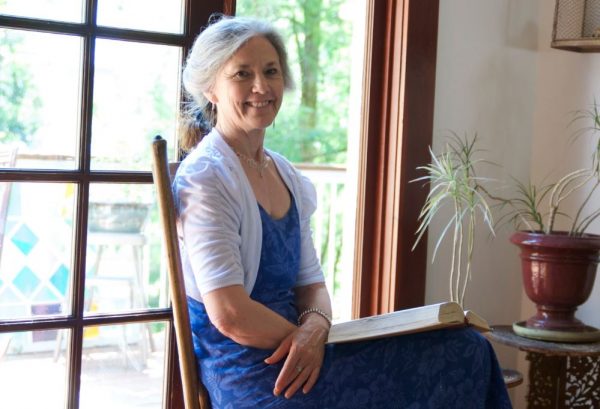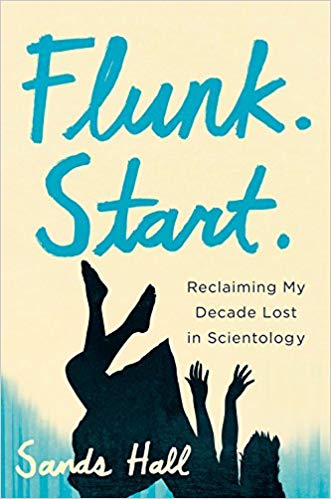Our Saturday ‘Scientology Lit’ series continues with a glimpse of Sands Hall’s richly penned memoir, Flunk. Start.: Reclaiming My Lost Decade in Scientology. Sands, a veteran musician and writing instructor, may not have been a Sea Org member or high-ranking Scientology executive, but we found her book to be one of the best for explaining the “tech” that members encounter and the ways that Scientology affects the mind. She gave us this excerpt to share with you.
Her lovely face revealing nothing about the purpose or mood of our meeting, Jessica ushered me into her office and closed the door. On her desk lay a large red book embossed with gold letters. I recognized it. It was one of a dozen volumes that contained, in chronological order, all the policy letters and bulletins that L. Ron Hubbard had written regarding auditing, Scientology’s form of counseling. A bookcase behind Jessica’s desk held the entire set, bound in red leather, with an inch-and-a-half gap where this one had been removed. Another bookcase held the equally large set of “admin” volumes, bound in green, which contained everything Hubbard had ever written about how to found and run an organization. Of course Jessica kept these books close to hand. As the mission holder of a Scientology Center, she would refer to them often.
Jessica emanated serenity. She wore simple, elegant clothes, black and tan and linen. Her long hair was straight and glossy. She had unswerving faith in L. Ron Hubbard’s religious technology, yet even as she ensured that the mission (she called it a “Center,” choosing, with purpose, a less religiously charged word) adhered to his policies, she was never dictatorial. This was generally true of the Scientologists I’d come to know in my five years in the Church. I found them reasonable, kind, ethical, straightforward, and sane. Through the Church’s hermetic seal (especially hermetic in 1987, pre-Internet), whispers and speculation made their way: someone who’d done something wrong — “gone out-ethics” — had been chained for days to a toilet in a brig or forced to live in something like a gulag, eating rice and beans and doing menial labor, but these rumors had nothing to do with my own experience. Nevertheless, ever since the previous night — when, as I’d been finishing up my duties in the Center’s course room, Jessica had stopped in to request this meeting — I’d been anxious.
I perched on the edge of a chair, swallowed, and swallowed again.
She took her place on the other side of the desk and, folding her hands on its glossy surface, said, “Sands. You need to be firmer in the course room.”
I nodded, a little dazed, wondering what I might have done wrong.
My post at the Center was as a Course Supervisor. A Course Supervisor does not teach; she oversees the study going on in the course room — study that is entirely of materials written by Hubbard — making sure students understand what they are reading. So what Jessica was referring to might mean that I had not been absolutely vigilant as I checked a student’s understanding of one of Hubbard’s policy letters. Or maybe it was that student, Skip, who’d had so much trouble with the Training Routines. The previous week, he’d enrolled in the Success Through Communication course, but after just two nights, hadn’t returned. I was haunted by the story he’d told me, about a weekend retreat that was supposed to have taught him how to master fear but instead seemed to have fried his brain. If I’d passed him on a drill when he wasn’t ready to be passed, I might be responsible for whatever fragile mental state he might find himself in. Even though he’d come to us in a pretty fragile mental state.
“The Tech is the most precious thing,” Jessica was saying, her dark eyes serious. “You know that, Sands. If we’re to keep Scientology working, we must apply it correctly.”
She reached for the book on her desk, opened it to a marked page, and swiveled the volume around so I could see it.
I knew it well: an HCOPL — Hubbard Communications Office Policy Letter — written in February 1965 entitled “Keeping Scientology Working.”
Jessica cleared her throat. “‘We have some time since passed the point of achieving uniformly workable technology.’”
She was either reading upside-down or reciting. Many Scientologists memorized, word-for-word, chunks of what was known as the “Tech.”
“‘The only thing now is getting the technology applied,’” she quoted.
“I understand,” I said.
She smiled. “I’m sure you do. But I can hardly tell you to Keep Scientology Working without doing exactly what LRH says we must do if we are to keep Scientology working.”
I tried to smile back and bent my head to read the familiar words. This policy letter was the first thing you read each time you started a new Scientology course. Which meant I’d read it about a dozen times. I see now that the first sentence makes a statement as if it’s self-evident — “We have some time since passed the point of achieving uniformly workable technology” — and the other steps follow from that assumption. But at the time I did not spot how this led the reader, unquestioningly, into the second step — “Two: Knowing the technology.” After which comes:
Three: Knowing it is correct.
Four: Teaching correctly the correct technology.
Five: Applying the technology.
Six: Seeing that the technology is correctly applied.
I looked up from the page and again said, “I understand.”
And it was true that about this far I was usually able to follow Hubbard’s thinking, even if I found it awfully arrogant. He and he alone had come up with the only possible technology? Still, although I might not agree that it was the only correct technology, it did seem as if it might be — my knowledge was limited — a correct technology. I was not in the course room to teach the Tech, but I was doing my best to make sure students understood it. I understood that “applying Tech” meant living your life more or less by Hubbard’s policies and perspectives. Around this I was definitely wishy-washy: my faith in the validity of everything Hubbard had ever written or said was in no way absolute — some things actually scared me. But I did believe in the efficacy of a lot of it.
However, the next four steps to Keep Scientology Working really troubled me, even though I’d glibly demonstrated my understanding of them — which certainly implied agreement — any number of times. They were so adamant. I lowered my eyes to the page.
Seven: Hammering out of existence incorrect technology.
Eight: Knocking out incorrect application.
Nine: Closing the door on any possibility of incorrect technology.
Ten: Closing the door on incorrect application.
“Sands,” Jessica said. “We must, as LRH says, ‘close the door on any possibility of incorrect application.’” I nodded, wondering what door of “incorrect application” I’d left ajar. And who had noticed? Who’d brought it to Jessica’s attention? The only thing I could think of was Skip. Poor Skip! How on earth could he live with the images in his head?
Jessica turned the page and pointed to a paragraph at the end of the document.
The whole agonized future of the planet, every Man, Woman and Child on it, and your own destiny for the next endless trillions of years depend on what you do here and now with and in Scientology.
I knew the rest of this paragraph. This was a “deadly serious” activity. If we didn’t manage to “get out of the trap” now, we might never have another chance. The inherent hysteria made me roll my eyes, just a bit. Humans had been on the planet a long, long time.
Which, I also understood, was part of Hubbard’s point.
“If we falter in delivering the Tech in a completely standard way, Sands, we risk losing it.” Jessica’s voice had the slightest wobble in it. It wasn’t just that her own status as the mission holder was on the line if the Center was found to be delivering anything other than Standard Tech — a terrifying idea for all involved. It was also the idea that under her watch, Scientology might not work as it was meant to work. I found this utterly noble and beautiful, even as inside the little cat of doubt I knew so well stretched a paw and yawned.
“We need you to be a zealot, Sands.”
I blinked. The blood in my veins came to a halt. “A zealot?”
She nodded. My blood began to pump again. Actually, it lurched and spun as through my head roiled visions of men holding gleaming scimitars in one hand and in the other, gripped by their long hair, the bleeding lopped-off heads of women. I saw horses screaming and rearing as their riders stormed through a crowd of unbelievers. I saw a little girl, held by her ankles, whirled against a rock to smash her heathen forehead. I saw a hundred Muslim bodies impaled on sharp poles, left to writhe and die. I saw Christians opening their arms to welcome the hungry lions that, mouths agape, raced toward them across a Roman ring.
“At times you are too gentle,” Jessica said.
I could only stare, caught up in the sight and sound and smell and filth of carnage in the name of faith.
“At times you allow yourself to be swayed by someone you think of as stronger than you — or, what I mean is, if you think they’re smarter. Especially if that person is male.”
I nodded. This was inarguable. My father. My brother. The man I’d married, Jamie, whose brilliance as a musician helped persuade me that he might also be brilliant about his chosen spiritual path, which was how I’d come to Scientology in the first place. My current sweetheart, Skye, was tenderer, but the quicksilver quality of his mind, and his marvelous sense of humor, caused me to sometimes wonder whether his thoughts might be better than my own.
Except for the volume open between us, the surface of Jessica’s desk held only a photo in a frame and a small potted plant, and she ran a hand over the gleaming rosewood. “Delivering the Tech has nothing, nothing to do with being ‘nice.’ Let me remind you — you’re the one who pointed it out to me — that the root of the word ‘nice’ is ‘foolish.’”
“Well,” I said, “ignorant, anyway.”
“You are not ignorant. Nor foolish! So don’t be ‘nice.’ I worry that you’d rather be liked than risk offending a student by sending him back to, say, restudy material.”
Again I tried to think where I’d been lax. After taking the Course Supervisor Course I’d had to do an internship in a course room, and I thought I’d gotten pretty good at telling people to restudy their materials if I felt they had to. Hubbard’s Study Tech was an aspect of Scientology in which I completely believed.
“That’s what I mean by ‘zealot,’” Jessica said. “If Scientology is applied standardly, we know it works.”
I thought about Skip. I wondered if the Tech had helped him. I worried that by now he’d blown his brains out.
— Sands Hall
——————–
OK, ZUCKERBERG, YOU WIN
As we announced yesterday, we’ve created a Facebook Group for the Underground Bunker and its community, where you can spend even more time discussing Scientology news. It should be a lot of fun, or maybe it will be a big headache, or maybe Facebook itself will collapse in a grand conflagration of regrets and recriminations. Who can tell! Please join the madness if you wish.
——————–
Bernie Headley has not seen his daughter Stephanie in 5,182 days.
Katrina Reyes has not seen her mother Yelena in 1,785 days
Brian Sheen has not seen his grandson Leo in 328 days.
Geoff Levin has not seen his son Collin and daughter Savannah in 216 days.
Clarissa Adams has not seen her parents Walter and Irmin Huber in 1,391 days.
Carol Nyburg has not seen her daughter Nancy in 2,165 days.
Jamie Sorrentini Lugli has not seen her father Irving in 2,939 days.
Quailynn McDaniel has not seen her brother Sean in 2,285 days.
Dylan Gill has not seen his father Russell in 10,851 days.
Mirriam Francis has not seen her brother Ben in 2,519 days.
Claudio and Renata Lugli have not seen their son Flavio in 2,779 days.
Sara Goldberg has not seen her daughter Ashley in 1,819 days.
Lori Hodgson has not seen her son Jeremy and daughter Jessica in 1,531 days.
Marie Bilheimer has not seen her mother June in 1,057 days.
Joe Reaiche has not seen his daughter Alanna Masterson in 5,146 days
Derek Bloch has not seen his father Darren in 2,286 days.
Cindy Plahuta has not seen her daughter Kara in 2,606 days.
Claire Headley has not seen her mother Gen in 2,581 days.
Ramana Dienes-Browning has not seen her mother Jancis in 937 days.
Mike Rinder has not seen his son Benjamin and daughter Taryn in 5,239 days.
Brian Sheen has not seen his daughter Spring in 1,345 days.
Skip Young has not seen his daughters Megan and Alexis in 1,748 days.
Mary Kahn has not seen her son Sammy in 1,620 days.
Lois Reisdorf has not seen her son Craig in 1,202 days.
Phil and Willie Jones have not seen their son Mike and daughter Emily in 1,707 days.
Mary Jane Sterne has not seen her daughter Samantha in 1,951 days.
Kate Bornstein has not seen her daughter Jessica in 13,060 days.
——————–
 Posted by Tony Ortega on July 21, 2018 at 07:00
Posted by Tony Ortega on July 21, 2018 at 07:00
E-mail tips and story ideas to tonyo94 AT gmail DOT com or follow us on Twitter. We post behind-the-scenes updates at our Facebook author page. After every new story we send out an alert to our e-mail list and our FB page.
Our book, The Unbreakable Miss Lovely: How the Church of Scientology tried to destroy Paulette Cooper, is on sale at Amazon in paperback, Kindle, and audiobook versions. We’ve posted photographs of Paulette and scenes from her life at a separate location. Reader Sookie put together a complete index. More information can also be found at the book’s dedicated page.
The Best of the Underground Bunker, 1995-2017 Just starting out here? We’ve picked out the most important stories we’ve covered here at the Undergound Bunker (2012-2017), The Village Voice (2008-2012), New Times Los Angeles (1999-2002) and the Phoenix New Times (1995-1999)
Learn about Scientology with our numerous series with experts…
BLOGGING DIANETICS: We read Scientology’s founding text cover to cover with the help of L.A. attorney and former church member Vance Woodward
UP THE BRIDGE: Claire Headley and Bruce Hines train us as Scientologists
GETTING OUR ETHICS IN: Jefferson Hawkins explains Scientology’s system of justice
SCIENTOLOGY MYTHBUSTING: Historian Jon Atack discusses key Scientology concepts
Other links: Shelly Miscavige, ten years gone | The Lisa McPherson story told in real time | The Cathriona White stories | The Leah Remini ‘Knowledge Reports’ | Hear audio of a Scientology excommunication | Scientology’s little day care of horrors | Whatever happened to Steve Fishman? | Felony charges for Scientology’s drug rehab scam | Why Scientology digs bomb-proof vaults in the desert | PZ Myers reads L. Ron Hubbard’s “A History of Man” | Scientology’s Master Spies | The mystery of the richest Scientologist and his wayward sons | Scientology’s shocking mistreatment of the mentally ill | The Underground Bunker’s Official Theme Song | The Underground Bunker FAQ
Our non-Scientology stories: Robert Burnham Jr., the man who inscribed the universe | Notorious alt-right inspiration Kevin MacDonald and his theories about Jewish DNA | The selling of the “Phoenix Lights” | Astronomer Harlow Shapley‘s FBI file | Sex, spies, and local TV news








